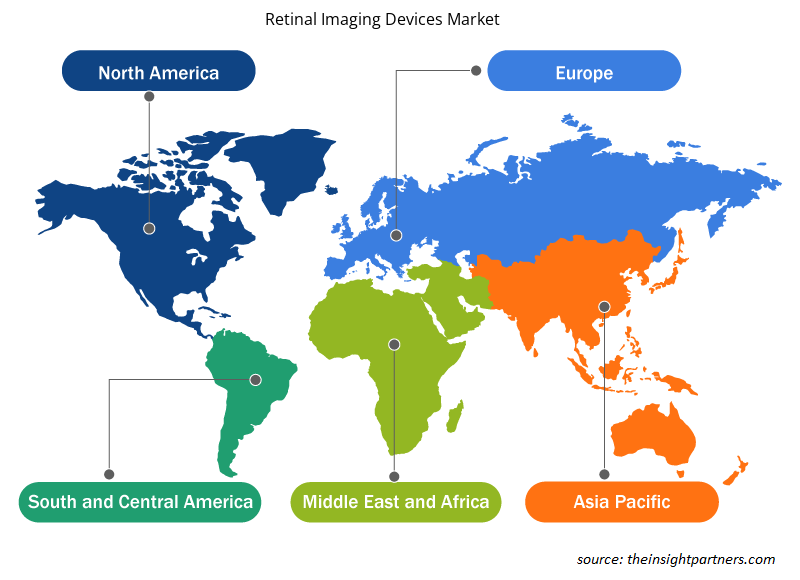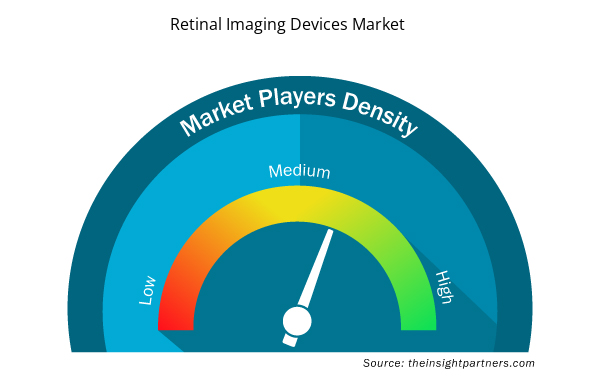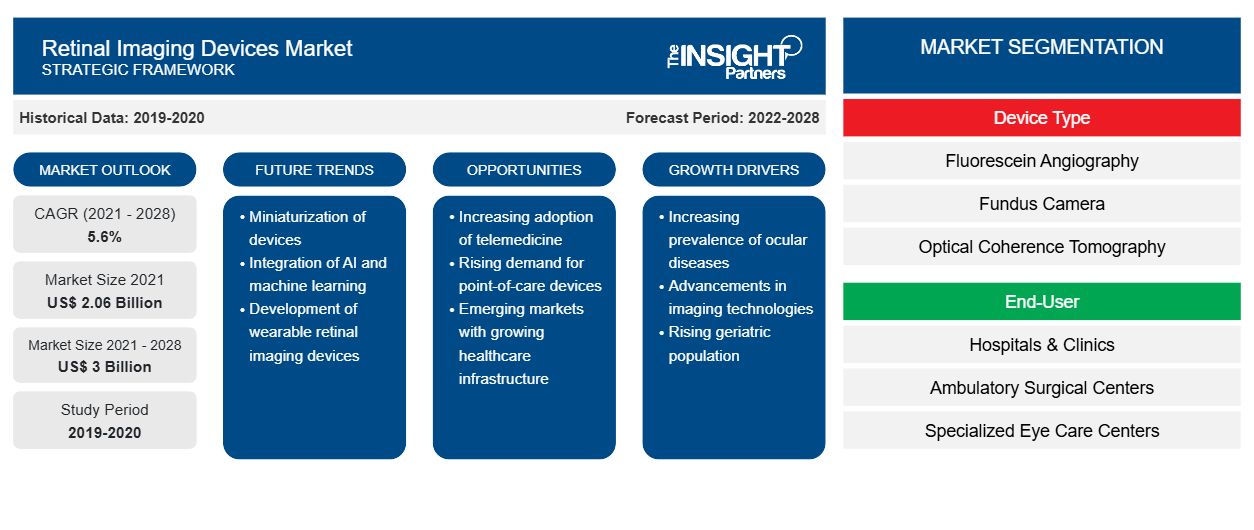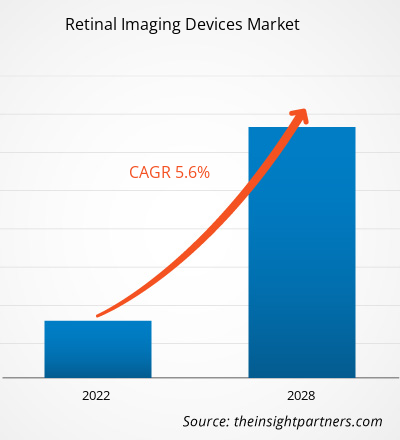網膜撮像装置市場は、2021年の20.6億米ドルから2028年には30億米ドルに達すると予測されており、2021年から2028年にかけて5.6%のCAGRで成長すると推定されています。
網膜イメージングは、患者の網膜の状態を分析して診断するために使用される技術です。網膜イメージング装置 (RID) は、高解像度のイメージング システムを使用して、眼球の内部の写真を撮影します。撮影された画像は、仮想プライベート ネットワーク (VSP) ネットワークの医師が網膜の健康状態を評価するのに役立ち、糖尿病、緑内障、黄斑変性症などの眼球および健康状態の検出と管理に役立ちます。
要件に合わせてレポートをカスタマイズする
このレポートの一部、国レベルの分析、Excelデータパックなど、あらゆるレポートを無料でカスタマイズできます。また、スタートアップや大学向けのお得なオファーや割引もご利用いただけます。
- このレポートの主要な市場動向を入手してください。この無料サンプルには、市場動向から見積もりや予測に至るまでのデータ分析が含まれます。
網膜イメージング装置市場の成長は、眼科医の網膜へのアクセスの改善、失明に対する世界的な取り組みの拡大、技術の進歩によるものです。しかし、OCT 装置の高コストが市場の成長を妨げています。
市場洞察
眼疾患の罹患率の上昇
網膜イメージング装置は、糖尿病性網膜症、加齢黄斑変性、緑内障、眼黒色腫、軽度の視力障害など、さまざまな眼関連疾患の診断と治療に広く使用されています。さらに、世界中で失明や視力障害への懸念が大幅に高まっています。世界保健機関(WHO)が2021年10月に発表したデータによると、約22億人が視力障害または失明を抱えて生活しています。そのうち約10億件の視力障害症例は、適切な診断と治療によって予防できます。これらの10億人は、中程度または重度の遠視障害または失明に関連するさまざまな眼の問題を抱えています。画像関連の診断技術は、形態学的データセットに基づいて、眼疾患に前例のない成長をもたらし始めています。このような要因は、予測期間中に網膜イメージング装置市場を支援すると予想されます。
デバイスタイプに基づく分析
デバイスの種類に基づいて、世界の網膜イメージングデバイス市場は、フルオレセイン蛍光眼底造影、眼底カメラ、および光干渉断層撮影に分類されています。眼底カメラセグメントは、2021年に最大の市場シェアを占めました。眼底写真撮影は、電子フラッシュからスマートフォンベースのカメラ、さらに最近ではポータブル眼科検査キット(PEEK)へと変化しました。PEEKは、包括的な眼科検査のためのスマートフォンベースのアプリケーションです。これらのカメラの利点は、眼科医でなくても写真を撮影でき、ある程度のトレーニングをすれば、写真を評価することもできることです。ただし、光干渉断層撮影セグメントは、予測期間中に市場で最も高いCAGR 8.1%を記録すると予想されています。光干渉断層撮影により、一次画像では診断されないさまざまなレベルの黄斑虚血を評価できます。この技術は、眼の画像診断法の標準として使用されています。
エンドユーザーベースの洞察
エンドユーザーに基づいて、世界の網膜イメージング装置市場は、病院と診療所、専門診療所、外来ケアセンター、その他に分類されます。病院と診療所セグメントは2021年に市場で最大のシェアを占め、専門眼科ケアセンターは予測期間中に市場で最も高いCAGR 6.6%を記録すると予想されています。
網膜イメージングデバイス市場の地域別洞察
予測期間を通じて網膜イメージングデバイス市場に影響を与える地域的な傾向と要因は、Insight Partners のアナリストによって徹底的に説明されています。このセクションでは、北米、ヨーロッパ、アジア太平洋、中東、アフリカ、南米、中米にわたる網膜イメージングデバイス市場のセグメントと地域についても説明します。

- 網膜イメージングデバイス市場の地域別データを入手
網膜イメージングデバイス市場レポートの範囲
| レポート属性 | 詳細 |
|---|---|
| 2021年の市場規模 | 20.6億米ドル |
| 2028年までの市場規模 | 30億米ドル |
| 世界のCAGR(2021年~2028年) | 5.6% |
| 履歴データ | 2019-2020 |
| 予測期間 | 2022-2028 |
| 対象セグメント | デバイスタイプ別
|
| 対象地域と国 | 北米
|
| 市場リーダーと主要企業プロフィール |
|
網膜イメージングデバイス市場のプレーヤー密度:ビジネスダイナミクスへの影響を理解する
網膜イメージングデバイス市場は、消費者の嗜好の変化、技術の進歩、製品の利点に対する認識の高まりなどの要因により、エンドユーザーの需要が高まり、急速に成長しています。需要が高まるにつれて、企業は提供を拡大し、消費者のニーズを満たすために革新し、新たなトレンドを活用し、市場の成長をさらに促進しています。
市場プレーヤー密度とは、特定の市場または業界内で活動している企業または会社の分布を指します。これは、特定の市場スペースに、その市場規模または総市場価値に対してどれだけの競合相手 (市場プレーヤー) が存在するかを示します。
網膜イメージング装置市場で事業を展開している主要企業は次のとおりです。
- カールツァイスメディテック
- レベニオグループ
- 株式会社ニコン
- オプトメッド
- 株式会社トプコン
免責事項:上記の企業は、特定の順序でランク付けされていません。

- 網膜イメージングデバイス市場のトップキープレーヤーの概要を入手
地域別インサイト
地域別では、北米地域が2021年に最大のシェアを占め、予測期間中も同様の傾向が続くと予想されます。アジア太平洋地域は、予測期間中に最高の成長率を示すことが予想されます。シンガポールでの検査範囲を改善するために人工知能(AI)とディープラーニングシステム(DLS)を適用することで、今後7年間で地域の成長が促進されると予想されます。
製品の発売と承認は、企業が世界的な足跡と製品ポートフォリオを拡大するために一般的に採用されている戦略です。さらに、網膜イメージング装置市場のプレーヤーは、顧客を拡大するためのパートナーシップ戦略に重点を置いており、これにより世界中でブランド名を維持できます。
装置の種類に基づいて、網膜イメージング装置市場は、フルオレセイン血管造影、眼底カメラ、光干渉断層撮影に分類されます。エンドユーザーに基づいて、市場は病院と診療所、外来手術センター、専門眼科センター、およびその他のエンドユーザーに分割されます。地域別に見ると、網膜イメージング装置市場は、北米(米国、カナダ、メキシコ)、欧州(英国、ドイツ、フランス、イタリア、スペイン、その他の欧州)、アジア太平洋(中国、日本、インド、オーストラリア、韓国、その他のアジア太平洋)、中東およびアフリカ(UAE、サウジアラビア、南アフリカ、その他の中東およびアフリカ)、中南米(ブラジル、アルゼンチン、その他の中南米)に区分されています。当社の調査対象企業には、Carl Zeiss Meditec、Revenio Group Oyj、Nikon Corporation、Optomed、Topcon Corporation、Imagine Eyes、Epipole Ltd、Forus Health Pvt Ltd、Eyenuk Inc、Phoenix Technology Group LLC などがあります。
- 過去2年間の分析、基準年、CAGRによる予測(7年間)
- PEST分析とSWOT分析
- 市場規模価値/数量 - 世界、地域、国
- 業界と競争環境
- Excel データセット


- Vision Care Market
- Pressure Vessel Composite Materials Market
- Medical Devices Market
- Real-Time Location Systems Market
- Dealer Management System Market
- Virtual Event Software Market
- Aerospace Forging Market
- Artwork Management Software Market
- Nitrogenous Fertilizer Market
- Fish Protein Hydrolysate Market

Report Coverage
Revenue forecast, Company Analysis, Industry landscape, Growth factors, and Trends

Segment Covered
This text is related
to segments covered.

Regional Scope
North America, Europe, Asia Pacific, Middle East & Africa, South & Central America

Country Scope
This text is related
to country scope.
よくある質問
The global retinal imaging devices market is expected to reach US$ 3,009.55 million by 2028 from US$ 2,060.01 million in 2021; it is estimated to grow at a CAGR of 5.6% during 2021–2028.
The retinal imaging devices market majorly consists of players such as Carl Zeiss Meditec, Revenio Group Oyj, Nikon Corporation, Optomed, Topcon Corporation, Imagine Eyes, Epipole Ltd, Forus Health Pvt Ltd, Eyenuk Inc, and Phoenix Technology Group LLC among others.
The fundus camera type held the largest share of the market in 2021. However, the optical coherence tomography type is anticipated to register the highest CAGR of 8.1% in the market during the forecast period. The optical coherence tomography allows the evaluation of different levels of macular ischemia that are not diagnosed in primary imaging. The technique is used as a standard for imaging modalities for eyes.
The Asia Pacific registered as the fastest-growing region in the global retinal imaging devices market. The market in this region is expected to grow significantly in countries such as China, Japan, and India. The market is driven by the rising prevalence of eye diseases and related factors. In China, eye diseases such as uncorrected sight problems, limited access to ophthalmologists in rural parts are driving the market growth. Whereas in Japan, the cost of eye health is rising significantly, and in India, the prevalence of diabetic retinopathy is growing exponentially. Also, factors such as the rising geriatric population in South Korea and global initiatives such as Vision 2020 in Australia are likely to support the growth of the market during the forecast period
The growth of the market is attributed to the rising prevalence of eye diseases, growing global initiatives for blindness and technological advancement in ophthalmology drives the market growth. However, the high cost of OCT devices hampers the market growth.
Trends and growth analysis reports related to Life Sciences : READ MORE..
The List of Companies - Retinal Imaging Device Market
- Carl Zeiss Meditec
- Revenio Group Oyj
- Nikon Corporation
- Optomed
- Topcon Corporation
- Imagine Eyes
- Epipole Ltd
- Forus Health Pvt Ltd
- Eyenuk Inc
- Phoenix Technology Group LLC
The Insight Partners performs research in 4 major stages: Data Collection & Secondary Research, Primary Research, Data Analysis and Data Triangulation & Final Review.
- Data Collection and Secondary Research:
As a market research and consulting firm operating from a decade, we have published and advised several client across the globe. First step for any study will start with an assessment of currently available data and insights from existing reports. Further, historical and current market information is collected from Investor Presentations, Annual Reports, SEC Filings, etc., and other information related to company’s performance and market positioning are gathered from Paid Databases (Factiva, Hoovers, and Reuters) and various other publications available in public domain.
Several associations trade associates, technical forums, institutes, societies and organization are accessed to gain technical as well as market related insights through their publications such as research papers, blogs and press releases related to the studies are referred to get cues about the market. Further, white papers, journals, magazines, and other news articles published in last 3 years are scrutinized and analyzed to understand the current market trends.
- Primary Research:
The primarily interview analysis comprise of data obtained from industry participants interview and answers to survey questions gathered by in-house primary team.
For primary research, interviews are conducted with industry experts/CEOs/Marketing Managers/VPs/Subject Matter Experts from both demand and supply side to get a 360-degree view of the market. The primary team conducts several interviews based on the complexity of the markets to understand the various market trends and dynamics which makes research more credible and precise.
A typical research interview fulfils the following functions:
- Provides first-hand information on the market size, market trends, growth trends, competitive landscape, and outlook
- Validates and strengthens in-house secondary research findings
- Develops the analysis team’s expertise and market understanding
Primary research involves email interactions and telephone interviews for each market, category, segment, and sub-segment across geographies. The participants who typically take part in such a process include, but are not limited to:
- Industry participants: VPs, business development managers, market intelligence managers and national sales managers
- Outside experts: Valuation experts, research analysts and key opinion leaders specializing in the electronics and semiconductor industry.
Below is the breakup of our primary respondents by company, designation, and region:

Once we receive the confirmation from primary research sources or primary respondents, we finalize the base year market estimation and forecast the data as per the macroeconomic and microeconomic factors assessed during data collection.
- Data Analysis:
Once data is validated through both secondary as well as primary respondents, we finalize the market estimations by hypothesis formulation and factor analysis at regional and country level.
- Macro-Economic Factor Analysis:
We analyse macroeconomic indicators such the gross domestic product (GDP), increase in the demand for goods and services across industries, technological advancement, regional economic growth, governmental policies, the influence of COVID-19, PEST analysis, and other aspects. This analysis aids in setting benchmarks for various nations/regions and approximating market splits. Additionally, the general trend of the aforementioned components aid in determining the market's development possibilities.
- Country Level Data:
Various factors that are especially aligned to the country are taken into account to determine the market size for a certain area and country, including the presence of vendors, such as headquarters and offices, the country's GDP, demand patterns, and industry growth. To comprehend the market dynamics for the nation, a number of growth variables, inhibitors, application areas, and current market trends are researched. The aforementioned elements aid in determining the country's overall market's growth potential.
- Company Profile:
The “Table of Contents” is formulated by listing and analyzing more than 25 - 30 companies operating in the market ecosystem across geographies. However, we profile only 10 companies as a standard practice in our syndicate reports. These 10 companies comprise leading, emerging, and regional players. Nonetheless, our analysis is not restricted to the 10 listed companies, we also analyze other companies present in the market to develop a holistic view and understand the prevailing trends. The “Company Profiles” section in the report covers key facts, business description, products & services, financial information, SWOT analysis, and key developments. The financial information presented is extracted from the annual reports and official documents of the publicly listed companies. Upon collecting the information for the sections of respective companies, we verify them via various primary sources and then compile the data in respective company profiles. The company level information helps us in deriving the base number as well as in forecasting the market size.
- Developing Base Number:
Aggregation of sales statistics (2020-2022) and macro-economic factor, and other secondary and primary research insights are utilized to arrive at base number and related market shares for 2022. The data gaps are identified in this step and relevant market data is analyzed, collected from paid primary interviews or databases. On finalizing the base year market size, forecasts are developed on the basis of macro-economic, industry and market growth factors and company level analysis.
- Data Triangulation and Final Review:
The market findings and base year market size calculations are validated from supply as well as demand side. Demand side validations are based on macro-economic factor analysis and benchmarks for respective regions and countries. In case of supply side validations, revenues of major companies are estimated (in case not available) based on industry benchmark, approximate number of employees, product portfolio, and primary interviews revenues are gathered. Further revenue from target product/service segment is assessed to avoid overshooting of market statistics. In case of heavy deviations between supply and demand side values, all thes steps are repeated to achieve synchronization.
We follow an iterative model, wherein we share our research findings with Subject Matter Experts (SME’s) and Key Opinion Leaders (KOLs) until consensus view of the market is not formulated – this model negates any drastic deviation in the opinions of experts. Only validated and universally acceptable research findings are quoted in our reports.
We have important check points that we use to validate our research findings – which we call – data triangulation, where we validate the information, we generate from secondary sources with primary interviews and then we re-validate with our internal data bases and Subject matter experts. This comprehensive model enables us to deliver high quality, reliable data in shortest possible time.


 このレポートの無料サンプルを入手する
このレポートの無料サンプルを入手する